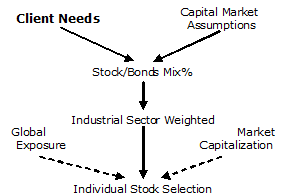Simpson Capital’s portfolio management style applied to your portfolio is based on a concept with the mundane title, Modern Portfolio Theory (MPT). First developed in 1959, it hypothesized risk-averse investors can construct portfolios to maximize expected return based on a desired level of market risk. This desired risk, corresponding to your risk tolerance, is an integral part of your investment reward.
A diversified portfolio is less risky and has greater potential for return than the collective total of its individual holdings. In Aristotle’s words, “the whole is greater than the sum of its parts”. The behavior of the holdings interact with each other resulting in a more desirable outcome. MPT is one of the most important and influential economic theories dealing with finance and investment.
MPT Features Diversification Benefits
Diversification eliminates idiosyncratic risk, which is the risk inherent in a particular investment due to the unique characteristics of that investment. MPT suggests it is not enough to look at the expected risk and return of each particular stock. By investing in more than one stock, you can reap the benefits of diversification, particularly a reduction in the riskiness of the overall portfolio. MPT quantifies the benefits of diversification, also known as not putting all of your eggs in one basket.
When using MPT, an investor bundles different types of investments together so portfolio assets are inversely correlated. Put simply, the securities counterbalance one another such that when some of the securities fall in value, other securities rise an equal amount. The same principal is found in harnessing the jerkiness of the combustion in an automobile engine: not all the cylinders fire at the same time. Thus, the crankshaft turns smoothly and the overall portfolio stays even.
But as markets rise overall, the portfolio “boat” of securities rises along with the market’s rising tide.

MPT states the risk for individual stock returns has two components: Systematic Risk and Unsystematic Risk. Systematic risk are market risks which cannot be diversified away. Interest rates, recessions and wars are examples of systematic risks. Unsystematic risk, also known as “specific risk”, is specific to individual stocks and can be diversified away by increasing the number of stocks in your portfolio. It represents the component of a stock’s return which is not correlated with general market moves.
For every level of return, there is one portfolio which offers the lowest possible risk, and for every level of risk, there is a portfolio which offers the highest return. These portfolios can be determined mathematically and result in tracing the efficient frontier on a two dimension plot with risk and return on the axes.
MPT Shortcomings
MPT has some shortcomings in the real world. For starters, it often requires investors to rethink notions of risk. Sometimes it demands the investor take on a perceived risky investment (futures, for example) in order to reduce overall risk. That can be a tough sell to an investor unfamiliar with the benefits of sophisticated portfolio management techniques.
Furthermore, MPT assumes it is possible to select stocks whose individual performance is independent of other investments in the portfolio. But market historians have shown that there are no such instruments; in times of market stress such as the collapse in 2008, seemingly independent investments such as mortgage securities do, in fact, act as though they are related.
Likewise, it is logical to borrow to hold a risk-free asset and increase your portfolio returns, but finding a truly risk-free asset is another matter. Government-backed bonds are presumed to be risk free, but, in reality, they are not. Securities such as gilts and U.S. Treasury bonds are free of default risk, but expectations of higher inflation and interest rate changes can both affect their value.
Then there is the question of the number of stocks required for diversification. How many is enough? Mutual funds can contain dozens and dozens of stocks. Some experts say even 100 stocks is not enough to diversify away unsystematic risk. Others conclude you would come very close to achieving optimal diversity after adding the twentieth stock.
At the end of the day, portfolio theory is just a theory. A portfolio’s success rests on the investor’s skills and the time he or she devotes to it.
MPT Applied at Simpson Capital
In practice, SCM boils down MPT to a simple, conservative and workable framework when constructing and monitoring your investment holdings. Your portfolio is limited to the asset classes of stocks, bonds and cash equivalents. We take only long positions and keep the number of equity positions in your portfolio to around twenty.

At left is a flowchart of SCM’s process used to manage your portfolio. It starts by determining your risk/return profile of desired return types (growth vs. current income), liquidity and risk tolerance through personal interviews. It makes assumptions about the future risk/return characteristics of capital asset classes. These profiles are matched and investment guidelines established. Further layers of risk management such as industrial sectors, global exposure and market capitalization are integrated into your portfolio construction.
To learn more about how SCM can integrate MPT into management of your investment portfolio to improve your rewards, visit our Portfolio Management, Account Investment Guidelines and Portfolio Strategies pages.


